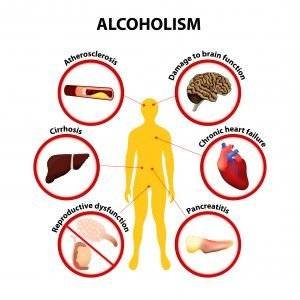 When someone starts out drinking, he or she feels relaxed, confident, happy, sociable… The pleasurable effects of alcohol are undeniable. It makes it easy to forget about the negative effects: slowed reflexes, reduced coordination, warped thinking, poor judgement, impaired memory, impaired motor functions, and plenty more impairments.
When someone starts out drinking, he or she feels relaxed, confident, happy, sociable… The pleasurable effects of alcohol are undeniable. It makes it easy to forget about the negative effects: slowed reflexes, reduced coordination, warped thinking, poor judgement, impaired memory, impaired motor functions, and plenty more impairments.
These negative effects occur every single time one drinks, even a single beer. The more one drinks, the stronger these negative effects. (Those pleasurable effects will begin to fade quickly). Over time, the body becomes damaged from drinking… more damaged than you probably know. In fact, alcohol can cause several types of cancer.
Aside from bodily harm, alcohol use has been linked to depression, anxiety, societal withdrawal, violent behavior, an increase in unprotected sex, and increased risk of motor vehicle accidents, suicide, injury, domestic violence, and even drowning. As if that’s not enough, alcohol does unbelievable damage to the body, and not just to the brain and liver. Virtually every part of the body is affected negatively from excessive drinking.
Let’s discover the truth about what alcohol does to the human body.
From the First Sip
When alcohol is consumed, around 33% of it gets absorbed immediately into the blood, through the stomach lining. The remaining alcohol is absorbed more slowly into the blood, through the small intestine. Once in the bloodstream, alcohol diffuses into almost every biological tissue in the body, because cell membranes are highly permeable.
When one consumes more alcohol than his or her body can handle, that person’s blood alcohol level (BAL) increases. How fast a person’s BAL raises, and the effects it has, vary greatly depending on a number of things, including weight, age, gender, body composition, general health, and the presence of other drugs or medications.
Regardless, the presence of alcohol in the blood at all will have effects on the body. A higher BAL simply means greater risk. The recommended maximum intake of alcohol is 2 drinks per day for men and 1 drink per day for women. Consuming more than this is considered problematic drinking. Five or more drinks per day for men, (four for women), is considered binge drinking.
Right from the first sip, alcohol affects the body. Starting with the brain, what follows is an explanation of the effects alcohol has on various parts of the body. Hold on tight.
Note: Alcoholism is a disease characterized by: inability to control alcohol use, a need to consume increasingly larger amounts of alcohol, and/or a constant impulse to consume alcohol. If this sounds familiar, please seek professional treatment immediately. With the right help, alcoholism is a 100% curable disease.
 Brain
Brain
The amount of damage alcohol causes to the brain is incomprehensible. Those little moments you don’t remember from the crazy night before – that’s temporary amnesia. Keep it up and you can develop Wernicke-Korsakoff Syndrome (WKS), a memory-impairing, vision-and-speech-affecting, seizure-causing disorder. You won’t be able to form new memories. You’ll mumble involuntarily. Your eyes will twitch constantly.
And that’s not all. Drinking releases excess GABA and dopamine, two naturally occurring neurotransmitters. GABA is responsible for calming the brain down, and dopamine is responsible for pleasure, a part of the brain’s reward system. Too much of these neurotransmitters can lead to shortness of breath, high blood pressure, increased heart rate, night terrors, delusions, hallucinations, spasms, and increased levels of both aggression and depression.
Drinking also releases endorphins, which are similar to neurotransmitters except they carry natural pain-reducing chemicals instead of ‘messages’. Endorphins are normally released upon rewarding actions, such as exercise, sexual activity, eating, etc. Too much endorphin release can cause depression, lower sex drive, low testosterone, infertility, and extreme fatigue, among other complications.
Liver
My oh my, how the liver takes a hit when you get drunk. Your liver is where alcohol gets metabolized if and when you drink more than one drink per hour, on average. Let’s face it – that’s extremely slow even for a casual drinker. The liver turns alcohol into something called acetaldehyde, which is toxic and can cause cancer. Anyway, let’s start at the start. Click here for more information about how alcohol ruins the liver.
Excess drinking causes the liver to accumulate fat, which can lead to fatty liver disease. A liver that has become clogged with fat cannot perform at an efficient level, which affects the rest of the body. Fatty liver disease, (extremely common), can lead to inflammation of the liver, which is known as alcoholic hepatitis, (more common than you think).
Excessive drinking, especially with alcoholic hepatitis, can also lead to cirrhosis. Cirrhosis of the liver happens when liver cells become so damaged that they cannot regenerate. Once cirrhosis has occurred, if a person does not stop drinking, they will experience liver failure which is extremely fatal. Liver cancer is a common outcome of drinking with cirrhosis.
Breasts
Alcohol consumption raises the risk for breast cancer. Research suggests that even so much as one drink a day may increase of person’s risk for breast cancer. Estrogen levels are raised when alcohol is consumed, and an increased estrogen level is a risk factor for developing breast cancer.
According to non-profit website Breastcancer.org, “Research consistently shows that drinking alcohol beverages… can increase levels of estrogen and other hormones associated with hormone-receptor-positive breast cancer.” It only three drinks a week for a woman to have a 15% higher risk. If that woman is fifteen years old or younger, her risk is tripled.
Stomach
Alcohol does two bad things to your stomach. One is that it makes the stomach produce more acid than usual, which can cause gastritis, and two is that alcohol creates irritation and inflammation in the stomach lining, which can lead to ulcers and bleeding of the stomach. If and when the stomach lining becomes torn, it can lead to anemia. Stomach pain after drinking alcohol could also be a sign of chronic cholecystitis, a condition of the gallbladder.
Pancreas
Excessive alcohol use is a common cause of pancreatitis, or inflammation of the pancreas, and it is major risk factor for pancreatic cancer. Heavy drinking also impairs the pancreas’ ability to produce insulin, which can lead to diabetes.
Heart
Heavy drinking can be very hard on the heart. It causes cardiomyopathy, which is the stretching and drooping of heart muscle. It causes myocarditis, which is inflammation of the heart muscle, and it also causes arrhythmia, which is irregular heartbeat.
When alcohol is consumed, it raises blood pressure and blood lipids. This increases the risk of heart attack, hypertension, raised cholesterol and stroke.
Bones
Excessive drinking can accelerate the rate of bone deterioration and increase the risk for bone fracture and osteoporosis. Calcium is necessary from strong, dense bones and when alcohol is consumed it acts as a diuretic and flushes calcium from the bones making them weaker and more susceptible to fracture.
Central Nervous System
Alcohol affects the central nervous system, causing many short-term effects like slurred speech, blurred vision, weakened muscles, decreased reaction time and impaired memory. When alcohol is consumed excessively, it can cause cell damage in the central nervous system, creating a condition known as neuropathy. Neuropathy causes alternating feelings of weakness, burning, pain and numbness in the feet and hands.
Colon
Alcohol consumption, whether excessive or long-term or both, causes what are known as adenomas in the colon. These are tiny and benign tumors, and are harmless at this stage. However, adenomas can develop into polyps, which are larger and can be pre-cancerous.
In Conclusion
Alcohol is not friendly to the body. While your mind may find its effects fun, your body does not. Hangovers are still not completely understood by science, which cannot be good. Blackouts are extremely common, and are actually bouts of amnesia. Alcohol poisoning is rampant, and more than ten types of cancer can be caused by excessive drinking.
If you or a loved one is dependent on alcohol, please, seek immediate professional help.
Check out our list of the Top 10 Alcohol Treatment Centers in the USA.











